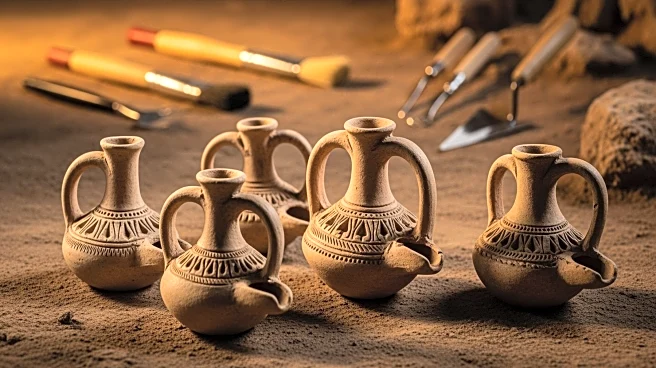What's Happening?
Archaeologists have uncovered the purpose of clay cornets, mysterious objects from 6,000 years ago found in parts of Israel and Jordan. These ceramic cones, resembling ice cream cones, were used as vigil
objects, serving as beeswax candles with linen wicks for ceremonial processions of fire. The discovery was made through analysis of cornets found at Teleilat Ghassul, a Chalcolithic site in Jordan. The study revealed that cornets were made at home and used in rituals, with each community manifesting the basic idea in their own way. The cornets were often broken and discarded after ceremonies, indicating their ritual significance.
Why It's Important?
The discovery of the purpose of clay cornets provides valuable insights into the cultural and ritual practices of ancient civilizations in the Chalcolithic period. Understanding the use of these objects helps archaeologists piece together the social and religious dynamics of early communities in the region. This finding contributes to the broader knowledge of ancient technologies and their role in ceremonial activities, highlighting the importance of ritual in shaping human societies. The study also demonstrates the potential for interdisciplinary research to solve long-standing archaeological mysteries.
What's Next?
Further research may focus on exploring other Chalcolithic sites to uncover more examples of cornets and their use in rituals. Archaeologists may also investigate the connections between these objects and other ceremonial artifacts from the period, seeking to understand the broader cultural context. The findings could inspire new studies on the evolution of ritual practices and their impact on social structures in ancient civilizations. Additionally, the methodology used in this study may be applied to other archaeological puzzles, advancing the field of archaeology.
Beyond the Headlines
The revelation about clay cornets underscores the importance of considering the human element in archaeological research. These objects reflect the creativity and individuality of ancient communities, offering a glimpse into their daily lives and spiritual beliefs. The study highlights the role of personal craftsmanship in ritual practices, suggesting that rituals were not only communal but also personal expressions of faith and tradition. This perspective may influence future archaeological interpretations, encouraging researchers to consider the personal and emotional dimensions of ancient artifacts.













